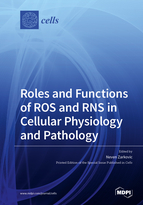Roles and Functions of ROS and RNS in Cellular Physiology and Pathology
A special issue of Cells (ISSN 2073-4409).
Deadline for manuscript submissions: closed (1 July 2019) | Viewed by 73124
Special Issue Editor
Interests: oxidative stress; growth regulation; cancer; lipid peroxidation; 4-hydroxynonenal (HNE)
Special Issues, Collections and Topics in MDPI journals
Special Issue Information
Dear Colleagues,
For decades, free radicals were considered mostly as harmful molecules that contribute to the toxic, mutagenic, and carcinogenic bioactivities of different chemical and physical stressors. However, after hydrogen peroxide and nitric oxide were found to have multiple, often cell-type and dose-dependent effects, the new era of interdisciplinary molecular biosciences and translation medicine made significant progress in studies on the pathophysiology of oxidative stress and associated disorders.
Therefore, the major goal of this Special Issue of Cells is to cover broad aspects of these important scientific areas, still focusing on the cellular level. However, since many disorders are based on altered cellular functions involving interactions of reactive oxygen species (ROS) and reactive nitrogen species (RNS) with macromolecules, in this Special Issue we also hope to tackle physiological and pathological aspects of cellular ROS and RNS related to specific cellular processes affecting the entire organism.
Prof. Neven Zarkovic
Guest Editor
Manuscript Submission Information
Manuscripts should be submitted online at www.mdpi.com by registering and logging in to this website. Once you are registered, click here to go to the submission form. Manuscripts can be submitted until the deadline. All submissions that pass pre-check are peer-reviewed. Accepted papers will be published continuously in the journal (as soon as accepted) and will be listed together on the special issue website. Research articles, review articles as well as short communications are invited. For planned papers, a title and short abstract (about 100 words) can be sent to the Editorial Office for announcement on this website.
Submitted manuscripts should not have been published previously, nor be under consideration for publication elsewhere (except conference proceedings papers). All manuscripts are thoroughly refereed through a single-blind peer-review process. A guide for authors and other relevant information for submission of manuscripts is available on the Instructions for Authors page. Cells is an international peer-reviewed open access semimonthly journal published by MDPI.
Please visit the Instructions for Authors page before submitting a manuscript. The Article Processing Charge (APC) for publication in this open access journal is 2700 CHF (Swiss Francs). Submitted papers should be well formatted and use good English. Authors may use MDPI's English editing service prior to publication or during author revisions.
Keywords
- free radicals
- redox balance and cell signalling
- antioxidants and oxidative homeostasis
- oxidative metabolism of the cells
- pathophysiology of oxidative stress







